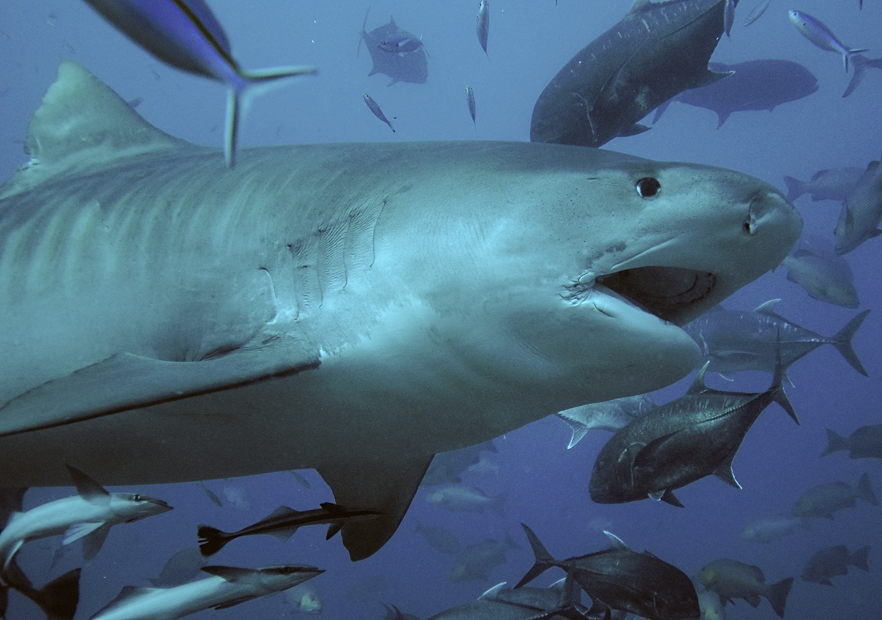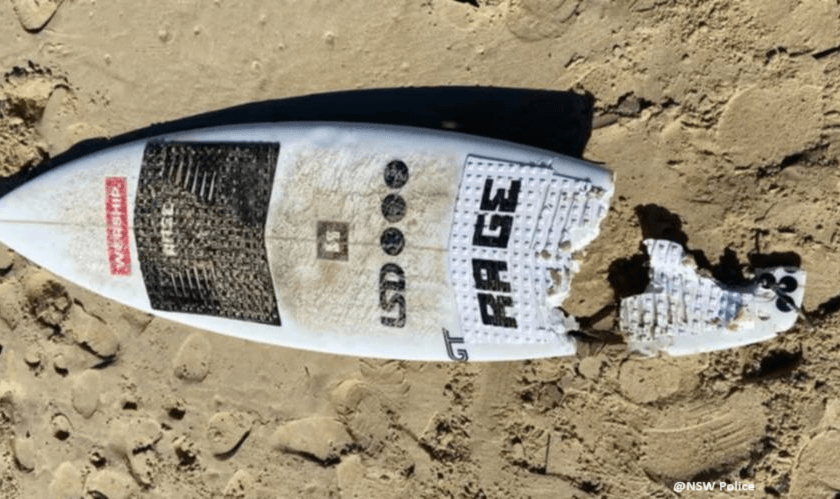In Part 1 of our series, we looked at origins of cage diving and what divers learned from those early expeditions. In Part 2, we visit the history of great white shark dive spots around the world.
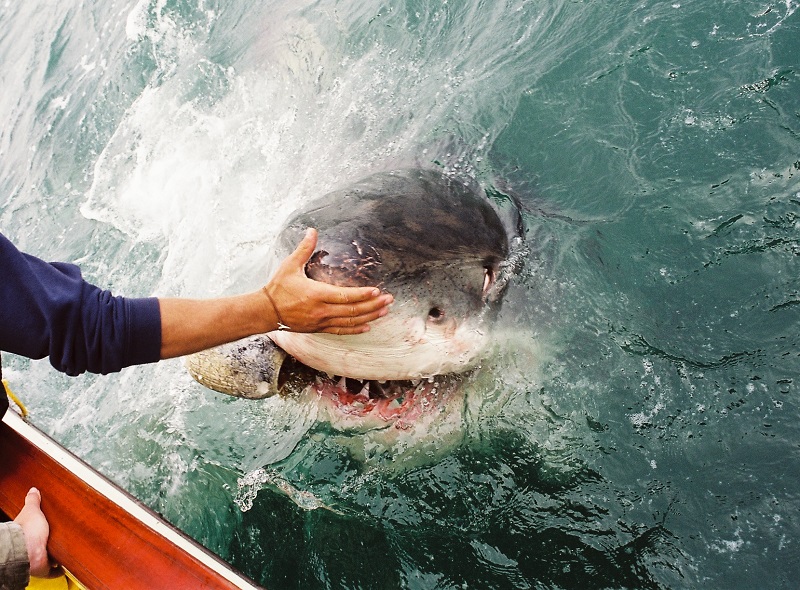
South Africa
In South Africa, cage diving is of younger origin and was only practiced sporadically in the western Cape Province around Struisbaai, east of Cape Agulhas, and in False Bay near Cape Town in the late 1980s. In 1997, seven commercial cage dive operators finally entered the Dyer Island Channel at Gansbaai.
Among them, hard and aggressive competition developed which disturbed research, seal and bird colonies. The events finally culminated in threats and trials between individual groups as more and more funds for films and ecotourism flowed to Gansbaai and led to a cowboy mentality.
Ironically, scientific organizations have received less and less research funding for the white shark research at Dyer Island and elsewhere, while commercial cages and travel agencies have made a fortune from the increasing flood of people who wanted to see and film white sharks.
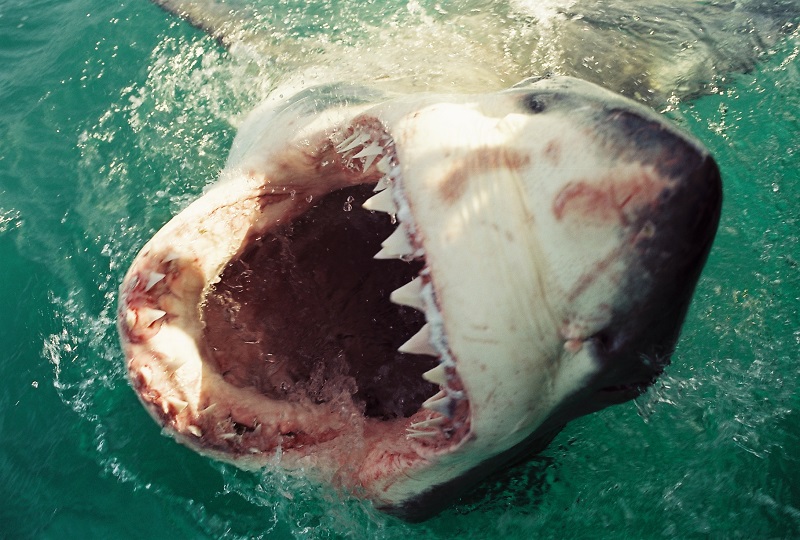
False Bay
In 2010, I repeated my trip to South Africa, but this time I visited shark researcher Chris Fallows in False Bay. His TV documentaries, “Air Jaws,” about the breaching white sharks are world famous.
With his boat Apex Predator, we went to Seal Island. We anchored nearly 100 meters (328 ft) from the island. The colony of Cape fur seals howled on the rocks and the wind rushed around my ears—it was a hellish noise—but, it was also a beautiful day with sunshine and calm sea, with numerous seals swimming around in the water.
I had just pulled on the neoprene suit to get into the cage when a white spray fountain of water exploded into the air, not far from the boat. I finally witnessed a white shark catapulting itself out of the sea to catch a seal. He jumped in complete silence and brought total destruction upon impact, a natural force that manifested itself as strong and invisible as a storm! The seal had no chance.
On this trip, I would deepen my studies, and I was surprised to learn something new: Chris did not use a chum to lure the great white sharks.
“We have found that the sharks are here anyway and we do not need blood to lure the animals to our boat. A few tuna-baits and our seal decoy are completely sufficient,” he told me. During this trip, we had eleven white sharks around our boat; the largest measured roughly more than 4 meters (13 ft).
The cages had changed a lot. Now, there were long, steel cages, which were attached to the boat, and had space for at least four to six people. When a shark approached the cage, we just dived down with the air in our lungs for a few seconds. There were no diving bottles or air hoses, and you did not need a diver’s license, just a little courage.
Not only are there large seal colonies in Gansbaai and False Bay, but also in Mossel Bay, some 400 kilometers (249 mi) farther east. Here you can also find a large rock with a seal population of around 3,000 animals. While in the first two locations the islands are located about five kilometers (3 mi) from the mainland, the seals in Mossel Bay are only 800 meters (2,625 ft) from the beach and very close to swimmers and surfers!
It could be assumed that there are many attacks on humans, but the opposite is the case. The only deadly attack took place in the vicinity on August 29, 2009 on surfer Gerhard van Zyl. His right lower leg was bitten off, and he died a little later in the hospital from the blood loss.
The seal colony is largely left alone by the sharks. As for the reason, Fallows suspects the white sharks in Mossel Bay are subadult animals up to a maximum of three meters (10 ft) in length. They hunt mainly fish and are not yet large enough to kill seals. Therefore, Mossel Bay is a kind of training camp for the sharks. Once they have learned to sneak and chase here, they swim farther south to Gansbaai and False Bay.
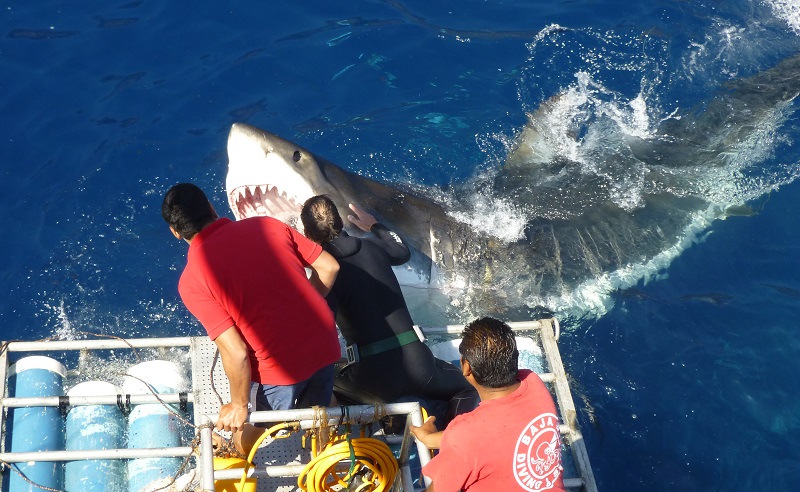
Guadalupe Island, Mexico
In 2013, my travels took me to Isla Guadalupe. This small volcanic island is 240 km (149 mi) west of the Mexican landmark Baja, California. The 32-kilometer long (20 mi) by 11-kilometer wide (7 mi) island is nothing more than a large deserted rock in the Pacific.
It is uncharted, without fresh water, just a spot on a sea chart. But for divers, it is a paradise. Next to South Africa and Australia, Isla Guadalupe is one of the most well-known meeting points for the world’s largest predator: Carcharodon carcharias, the great white shark!
About 200 great white sharks visit the island each season, of which 155 are known recurring individuals and, therefore, have received names from the researchers. All travelers by ship have the opportunity to experience the sharks in deep cages, which are lowered down 12 to 15 meters (39-49 ft).
For the surface cages, bottles are not used in this type of diving. The diver’s air supply comes from the mother ship using air hoses on the regulator. Emergency bottles in the cage are available. A special system of heavy lead diving weights is provided to ensure a comfortable and stable position in the cage. Fins are not used.
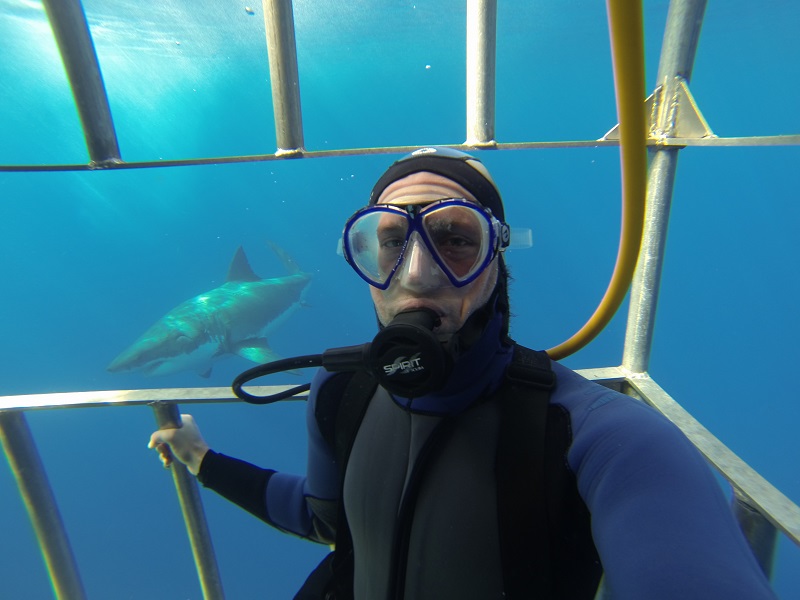
The cages meet the latest and most advanced standards from shark research and meet strict U.S. safety requirements. Safety at the highest level is required and guaranteed, as is maximum free view of sharks to assure everyone optimal opportunity for photos and filming. Cages can accommodate 2 to 4 people. Regular intervals with diver exchanges are evident, so no guest is disadvantaged and the great whites can be experienced as often and as close as possible.
Up to three animals are circling around my cage at the same time. Demonstrating their interest in the divers, they swim close to the cages and touch them gently. The deep cages can also be opened upward, which makes it possible to leave the cage quickly. There, in the water depth of 12 to 15 meters (39-49 ft), you are eye-to-eye with the great whites, an indescribable feeling when they slowly rise from the deep toward the cages.
While deep cages can only be used by certified divers, the surface cages offer nondivers an opportunity to experience the great whites up close. Here, the crew uses chum and tuna fish heads but if the sharks do not feel like it, they do not approach the boat.
The first day we waited desperately on board for the predators to come closer to the surface. We could make out their shadows about 20 to 30 meters (66-98 ft) below our cages, but that’s about it. If you only have four full-dive days and do not see sharks on the first day, you become very disappointed, especially when you think of the thousands of Euros you have just spent for such a trip. But you are not at the zoo, you are in the wild, and nothing can be planned!
During the next days, the sharks became more active. Up to four sharks now circled almost constantly around the cages, so close I could touch them, but since I wanted to keep my hands, I resisted the temptation.
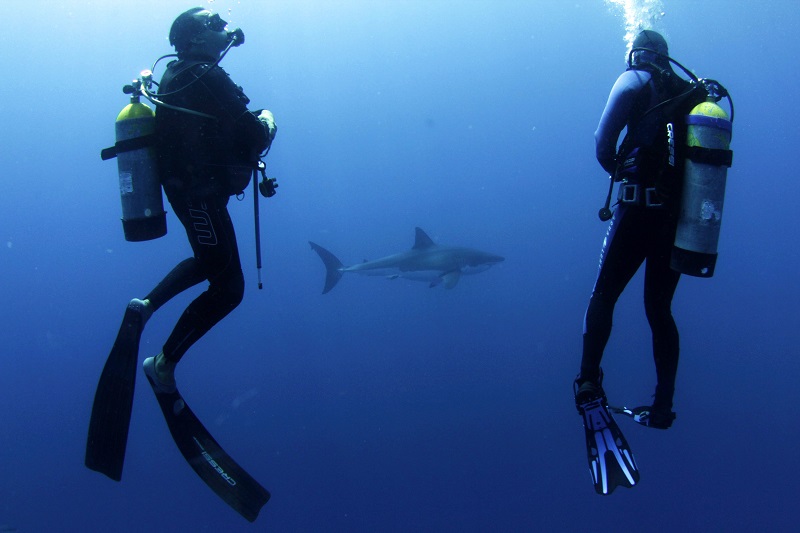
On Guadalupe, scientists can also dive outside the cage with the white sharks – but only with permission from the Mexican authorities. Photos of Apnea (free diving) divers like Frédéric “Fred” Buyle or Ocean Ramsey offer impressive evidence that white sharks do not necessarily equate humans with food.
A few years ago, the risky free diving (breath-holding) or diving outside a cage with other potentially dangerous shark species such as tiger sharks or bull sharks was considered impossible. Today, regular dive trips are organized from the Bahamas to the Fiji Islands to do just that.
So, what about Guadalupe? From my own experience, I know that out-of-cage diving has occurred at least since 2012. Again, the internet is full of proof photos. It is done unofficially and illegally, yes. But also without any attacks on the divers.
This concludes Part 2. Part 1 can be found here.
Check back soon for Part 3 of How Cage Diving with Great White Sharks Began.
Christian Kemper is a TV journalist from Germany. He has been diving with and studying sharks for more than 20 years. He has written two books about shark attacks and one book about crocodiles. He is a freelance writer for 3 of the biggest diving magazines in Germany.
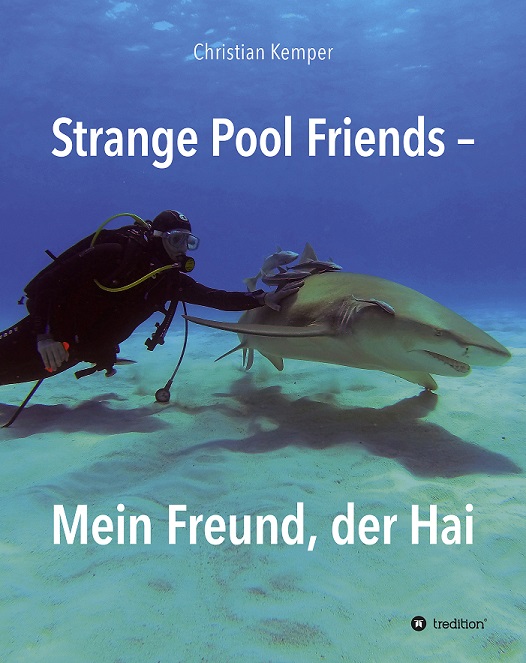
You can find his German language book Strange Pool Friends on Amazon and at https://tredition.de/.
He has also written a three part article about his scuba diving with tiger sharks at Tiger beach for Tracking Sharks.
